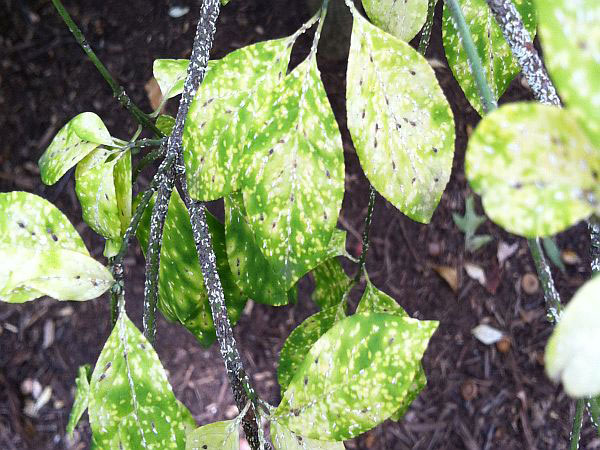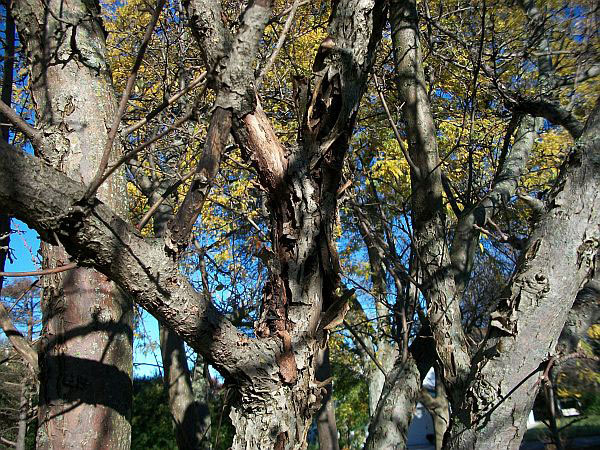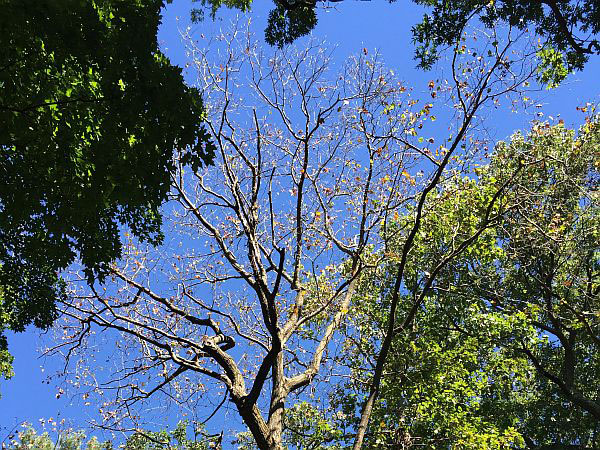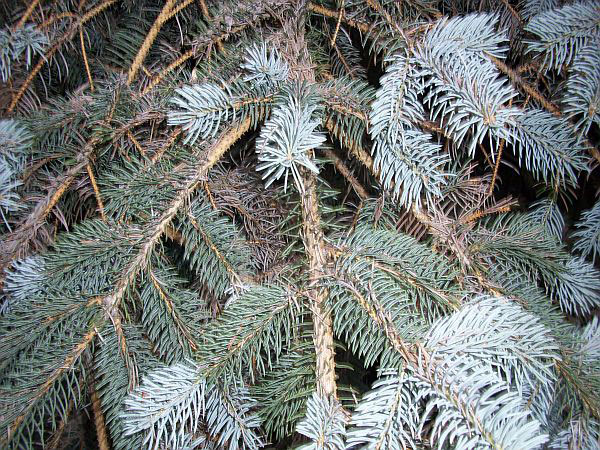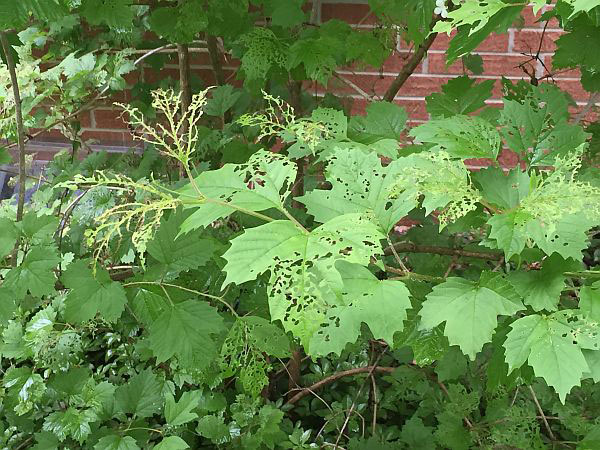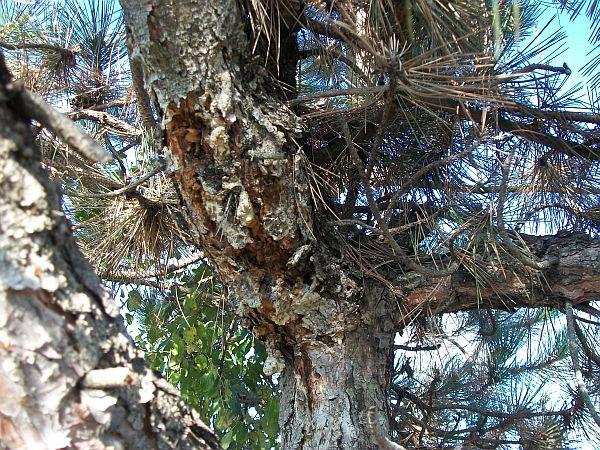Anthracnose
- Most commonly affects ash, maples, oaks, sycamore and walnuts.
- Anthracnose typically starts as small black spots on the leaves (often on the veins) and can cause dead areas on the leaves.
- The affected tissue is often brown and causes the leaves to curl and fall.
- Anthracnose is caused by several fungi that survive in leaf litter and is more common in years where the spring weather is cool and wet.
- Anthracnose is rarely a life-threatening condition.
Treatment:
- Keeping good plant health is the best treatment for Anthracnose. Putting trees on a plant health care program is a good way to help with Anthracnose infections.
Aphids
- Most commonly affects winged burning bush, lindens, flowering crabapples, hawthorns, spirea and viburnums.
- They feed on the sap of the plant and excrete a substance called honeydew.
- Honeydew can promote the growth of sooty mold (a black tar-like substance) which can attract ants and wasps and drip onto patio furniture.
- Aphids cause the plant to become deformed (curling leaves,) and can stunt growth as well as reduced plant health.
Treatment:
- Systemic soil insecticide treatments can be done in spring to help control/prevent aphids.
- Insecticide sprays can also be done in the summer months to help control/prevent aphids.
Apple Scab Fungus
- Affects plants in the rose family (most commonly affects flowering crabapples, pears, apples, mountain ash and hawthorns.
- Scab appears on the leaf as well as the fruit on the plants.
- Apple scab will first cause small black spots to form on the leaves. It will then spread and cause the leaves to become yellow.
- Severe infections can cause premature leaf drop in summer
- Spring weather that is cool and wet is most favorable for development of apple scab.
Treatment:
- To prevent future infections, annual fungicide applications can be made in the spring.
Black Knot
- Black knot is a fungus that affects and can kill trees in the prunus family. It most commonly attacks cherries and plums.
- In the first year of infection black knot will show up as greenish-brown swelling on branches.
- In the second year of the infection they will become black galls on the branches.
Treatment:
- Pruning the galls from the tree is the most effective way to deal with black knot. There is no effective chemical control for this fungus.
Cedar Apple Rust/Cedar Quince Rust
- Cedar Apple Rust symptoms occur in late May and form orangish/yellow spots on the leaves.
- Severe infections can cause premature leaf drop in summer
- Cedar Quince Rust occurs a few weeks after Cedar Apple Rust and primarily infects the fruit of the trees.
Treatment:
- To prevent future infections, annual fungicide applications can be made in the spring. While Cedar Apple Rust is fairly easy to control, Cedar Quince Rust can be very difficult to control
Chlorosis
- Chlorosis is a common issue in the southeastern part of Wisconsin. It is a lack of nutrients that causes leaves on the tree to turn yellow.
- It is most commonly found on pin oak, white oak, red maple, white pine and birch trees.
- Chlorosis is caused by the tree not having enough micronutrients (typically iron or manganese). It can either be a lack of nutrients in the soil or the tree is unable to absorb the nutrients through its roots.
Treatment:
- Trunk injections with liquid iron or manganese or fertilizer treatments with added micronutrients can help to correct chlorosis.
Cytospora Canker
- Cytospora canker is a fungal disease that most commonly affects Colorado blue spruce. Although it can affect Norway spruce, Douglas fir and balsam fir.
- The first signs of cytospora canker typically show up on lower branches and progresses up the tree. The needles will turn purple then brown and die.
- Infected branches can also produce a bluish-white sap that will ooze out of them.
Treatment:
- If the infection is caught early a trunk injection with fungicide in the spring/summer can help to control/prevent further infections.
- If the disease has spread too far in the tree removal and replacement is typically best.
Diplodia Needle Blight and Canker
- Diplodia is one of the most common fungal issues that affect pine trees in southeastern Wisconsin.
- Diplodia causes tip death and can kill entire branches.
- The fungus survives in infected needles and in the leaf litter under the tree.
Treatment:
- To prevent future infections, annual fungicide applications can be made in the spring and summer.
Dothistroma Needle Blight
- Dothristroma can affect many types of pine trees. It is caused by the fungus Dothistroma pini.
- Dothistroma will first appear as dark green spots on the needles. The spots can then become a reddish-brown color and can form bands around the needle.
- Dothistroma causes interior needle drop and thinning
Treatment:
- To prevent future infections, annual fungicide applications can be made in the spring and summer.
Dutch Elm Disease (DED)
- Dutch Elm Disease is a fatal fungal disease that affects all native North American Elms.
- The DED fungus is spread by elm bark beetles that breed and feed in elm trees or by root grafts and by pruning trees that are not in dormancy.
- The first sign of DED you will see is commonly a single branch with yellowing or wilting leaves.
- The fungus can quickly move through the plant and kill it in a matter of weeks or some trees can live for years with the fungus localized in one branch.
Treatment:
- Removal of infected trees is highly recommended to stop the spread from elm beetle feeding and root grafting.
- Fungicide injections can be done in the spring/summer to help prevent future infections from DED.
Emerald Ash Borer (EAB)
- Emerald Ash Borer is an insect that came over from China and it affects all true ash trees (not mountain ash).
- Causes decline and eventually death by boring into the wood and killing the vascular tissue that transports nutrients throughout the tree.
- Signs of EAB are bark flecking (bark has a lighter color and appears sunken, typically due to wood pecker damage), dieback starting in the upper canopy of the tree and growth of many water sprouts lower in the canopy.
Treatment:
- We recommend treatment of high value trees.
- The most effective treatment option is trunk injecting with Emamectin Benzoate every other year.
Euonymus Scale
- Euonymus scale is a non-native scale that attacks a variety of plants. It most commonly attacks shrub and vine forms of euonymus, privet, bittersweet and pachysandra.
- These insects feed on plant sap. It first appears as yellow spots on the leaves. On plants with heavy infestations the scale can cause defoliation and dieback of branches and the entire plant.
Treatment:
- Systemic soil insecticide treatments can be done in the spring to help control/prevent euonymus scale.
- Insecticide sprays can also be done in early to mid-June to help control/prevent euonymus scale.
European Pine Sawfly Larvae
- Pine Sawfly will feed on many different types of pines. The most common are Austrian, scots and mugo pines.
- A group of mature pine sawfly larvae can completely strip the needles from a branch.
- The European pine sawfly larvae are caterpillar looking and have a grayish-green in color with a shiny black head. They also have 5 parallel stripes that run the length of their body.
Treatment:
- Insecticide sprays can be done in the spring to control/prevent future insect infestations.
Fire Blight
- Fire blight is a deadly bacterial disease that affects plants in the rose family. It most commonly affects apples, flowering crabapples, hawthorns, pears and mountain ash.
- Branches and leaves affected by fire blight will curl and tend to stay on the plant. They get the appearance that they have been scorched.
Treatment:
- If your tree becomes infected with fire blight the diseased branches should be pruned out to try to stop the spread.
- Treatment options for fire blight are very limited.
- Many times the best option is tree removal and replacement.
Ips Bark Beetle
- Ips beetles typically attack and can kill already weak and stressed pine and spruce trees.
- The Ips beetles will cause needles to become yellow or brown. You can also see small (about ½” round) emergence holes on the trunk of the tree.
- There can also be a reddish dust at the base of the trees that Ips beetles are feeding on.
Treatment:
- Keeping the tree as healthy as possible is a good way to help keep Ips beetles from attacking your trees.
- Systemic soil insecticide treatments can be done in spring to help control/prevent Ips beetles.
- Insecticide sprays can also be done in the spring and summer to control/prevent Ips beetles.
Japanese Beetles
- Japanese Beetles are a serious pest to both trees and shrubs, as well as turf.
- The grubs feed on the roots of grass and the adults feed on the foliage of trees and shrubs.
- Common trees these insects love include lindens, birches, flowering crabapples, plums, and roses.
- Japanese beetles eat the green tissue between the veins of the plant, causing it to skeletonize.
Treatment:
- Soil insecticide or multiple foliar sprays.
Leafminers
- Leafminers are an insect that will attack a number of plant species. Some of the more common plants they attack are: birch (river and paper), arborvitae, hawthorn and elms.
- They feed on the tissue between the upper and lower layers of the leaves.
- Leafminers overwinter in the soil or in infected plant debris. Removing leaf litter from surrounding areas can help to control/prevent infestations.
Treatment:
- Soil insecticide treatments can be effective for treating for leafminers.
- Insecticide sprays can also be effective. They must be timed correctly because of the protected area where leafminers live and feed.
Magnolia Scale
- Magnolia scale is an insect that will attack magnolia trees. It most commonly attacks star magnolia and saucer magnolias.
- The insects look like small white and sometimes brown nodes on the plant.
- Magnolia scale will attach itself to branches and will suck nutrients from the plant. They will then excrete a sticky substance called honeydew.
- Another side effect from magnolia scale is the formation of sooty mold. Which is a black substance that can stain patios and lawn furniture.
Treatment:
- Systemic soil insecticide treatments can be done in the spring to help control/prevent magnolia scale.
- Another treatment option is to spray with a dormant oil in the early spring and an insecticide in the late summer/fall.
Oak Wilt
- Oak Wilt is caused by a lethal fungus that is spread by picnic beetles or by root grafts from other infected oak trees.
- Oak trees in the red oak group are most susceptible to oak wilt, where trees in the white oak group are less susceptible.
- Oak wilt initially starts as leaves on single branches wilting and falling off. It then spreads throughout the tree causing it to die.
Treatment:
- Remove diseased oaks (usually during the dormant season) so they do not spread oak wilt to healthy oaks.
- Trunk injections of Alamo are recommended to treat for Oak Wilt. (Preventative and some therapeutic treatments.)
- Only prune oaks in the dormant season to reduce the chance of spreading Oak Wilt.
Pine Needle Scale
- Pine needle scale is an insect that primarily attacks pine tree. It most commonly attacks scots and mugo pines, although it will attack Austrian and red pines as well as douglas-fir.
- When there is a heavy infestation the plant will appear frosted from the number of insects feeding on the nutrients.
- The insect yellows the needles by attaching and sucking plant nutrients from the branches.
Treatment:
- Systemic soil insecticide treatments can be done in the spring to help control/prevent pine needle scale.
- Insecticide sprays can be done in mid to late May to help control/prevent pine needle scale.
Powdery Mildew
- Powdery mildew is a fungus that appears on many ornamental plants. It most commonly affects lilacs, serviceberries, diablo ninebark, roses and alpine currants.
- The upper part of the leaves (and sometimes the lower) will have a white powdery appearance when powdery mildew is present.
- For most plants powdery mildew is an aesthetic issue. For some plants (roses and diablo ninebark) it can cause some dieback on branches that are infected.
Treatment:
- To prevent future infections, annual fungicide applications can be made in the spring and summer.
Rhizosphaera Needle Cast
- Rhizosphaera Needle Cast is one of the most common fungi to affect Colorado blue spruce. It can also affect other conifers including (but not limited to): black hills spruce, Austrian, mugo and eastern white pine and Douglas fir.
- Rhizospaera causes interior needle death and thinning. Eventually the entire branch dies.
- Rhizosphaera can spread by growing on needles that have either fallen or are still connected to the branches.
Treatment:
- To prevent future infections, annual fungicide applications can be made in the spring and summer.
Spider Mites
- Spruce spider mites attack a number of different conifers. They most commonly attack spruce, hemlock, arborvitae, larch and junipers.
- Spider mites feed by sucking nutrients out of the plant. They are most commonly found on inner branches.
- Needles with mite damage can have a yellowish to gray color. They can cause needles to brown and fall off prematurely.
Treatment:
- Sprays with targeted miticides can be used to control/prevent future infestations.
Tar Spot
- Tar spot is a fungal disease that affects all maples. It most commonly affects silver and Norway maples.
- Tar spot first shows up on the leaves as a small yellow spot. It will then become larger and black in color.
- For most trees tar spot is not a deadly disease. It is mostly an aesthetic issue. It can cause some defoliation later in the summer if the infection is severe.
Treatment:
- To prevent future infections, annual fungicide applications can be made in the spring and summer.
Verticillium Wilt
- Verticillium Wilt is a soil fungus that is present in most soils. It can be a deadly fungal infection that can affect many deciduous plants in WI. (Maple and ash are some of the most commonly affected trees.)
- Infections cause branches to wilt and die.
Treatment:
- The fungus cannot be eliminated, but we can extend the life of infected trees by proper fertilizing, watering, and fungicide treatments.
- We can also prune out the dead branches to improve the trees appearance.
Viburnum Leaf Beetles
- Viburnum Leaf Beetles only affect viburnums and more commonly, Arrowwood viburnum.
- Viburnum Leaf Beetle is a fairly new pest in southeast WI.
- This insect will feed on the green tissue between the veins of the plant, causing it to skeletonize, similar to Japanese Beetle damage.
Treatment:
- Soil insecticide or multiple foliar sprays.
Volutella Blight
- Volutella is a common and sometimes lethal fungus that attacks pachysandra ground cover and boxwood plants.
- Volutella causes pachysandra to wilt. It will cause boxwood leaves to become yellow and wilt. It can cause both plants to die.
- Volutella is commonly caused when leaves and stems get water soaked. Usually in very wet seasons and sometimes due to overwatering.
Treatment:
- Reducing plant stress and removing any infected debris from the area will help to keep future infections away.
- To prevent future infections, annual fungicide applications can be made in the spring and summer.
Zimmerman Pine Moth Borer
- ZPM typically attacks Austrian and Scots pines. It can also attack mugo and eastern white pine as well.
- They cause dieback by tunneling into new growth or into whorl areas causing pitch masses (areas where the tree has large masses of bleeding sap).
Treatment:
- Avoiding plant injury and environmental stresses can help to keep Zimmerman Pine Moth away by keeping the tree as healthy as possible.
- ZPM can be treated with an insecticide spray treatment in spring. There is also a fall treatment that can be done to help with heavy infestations.

